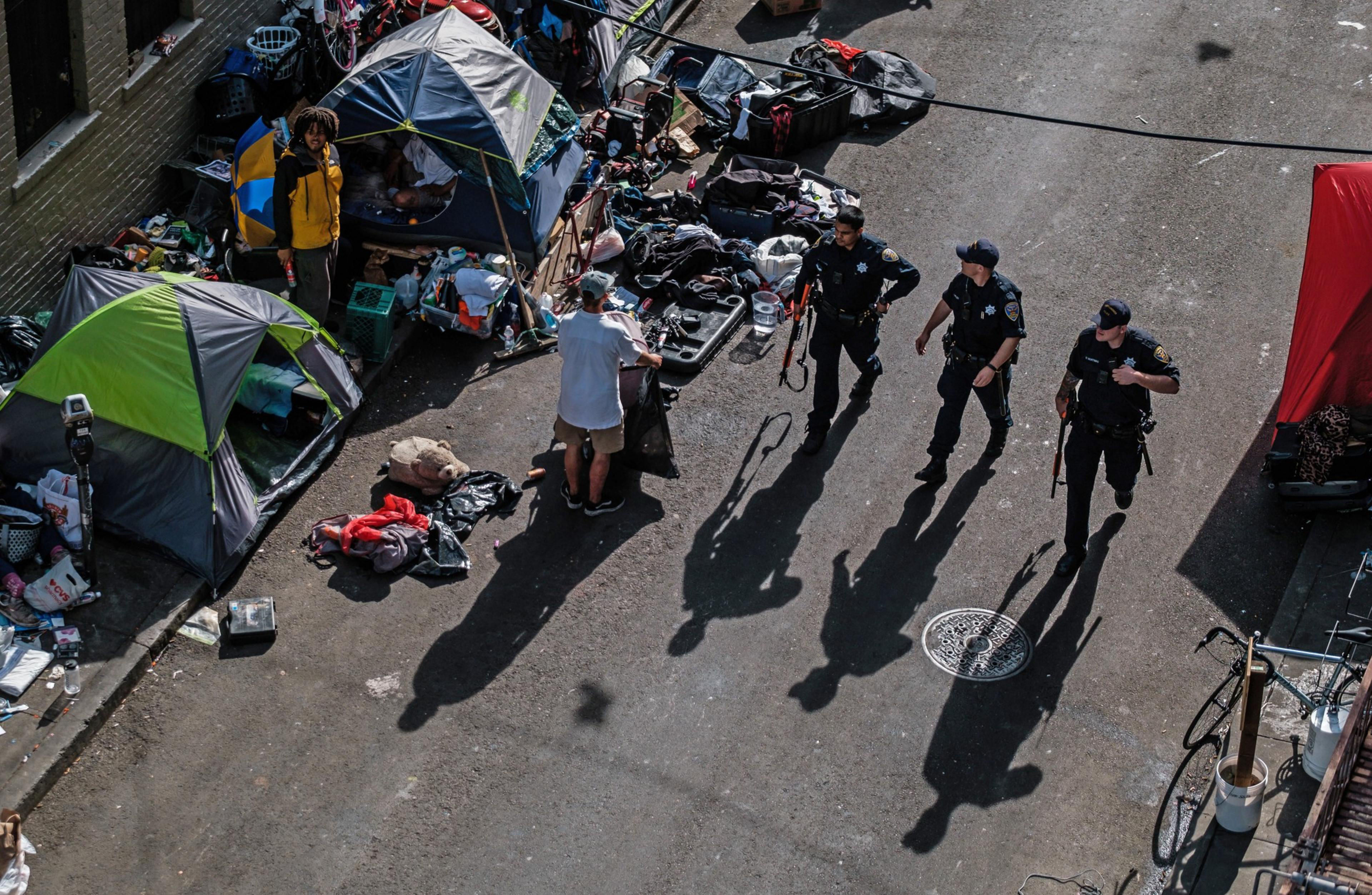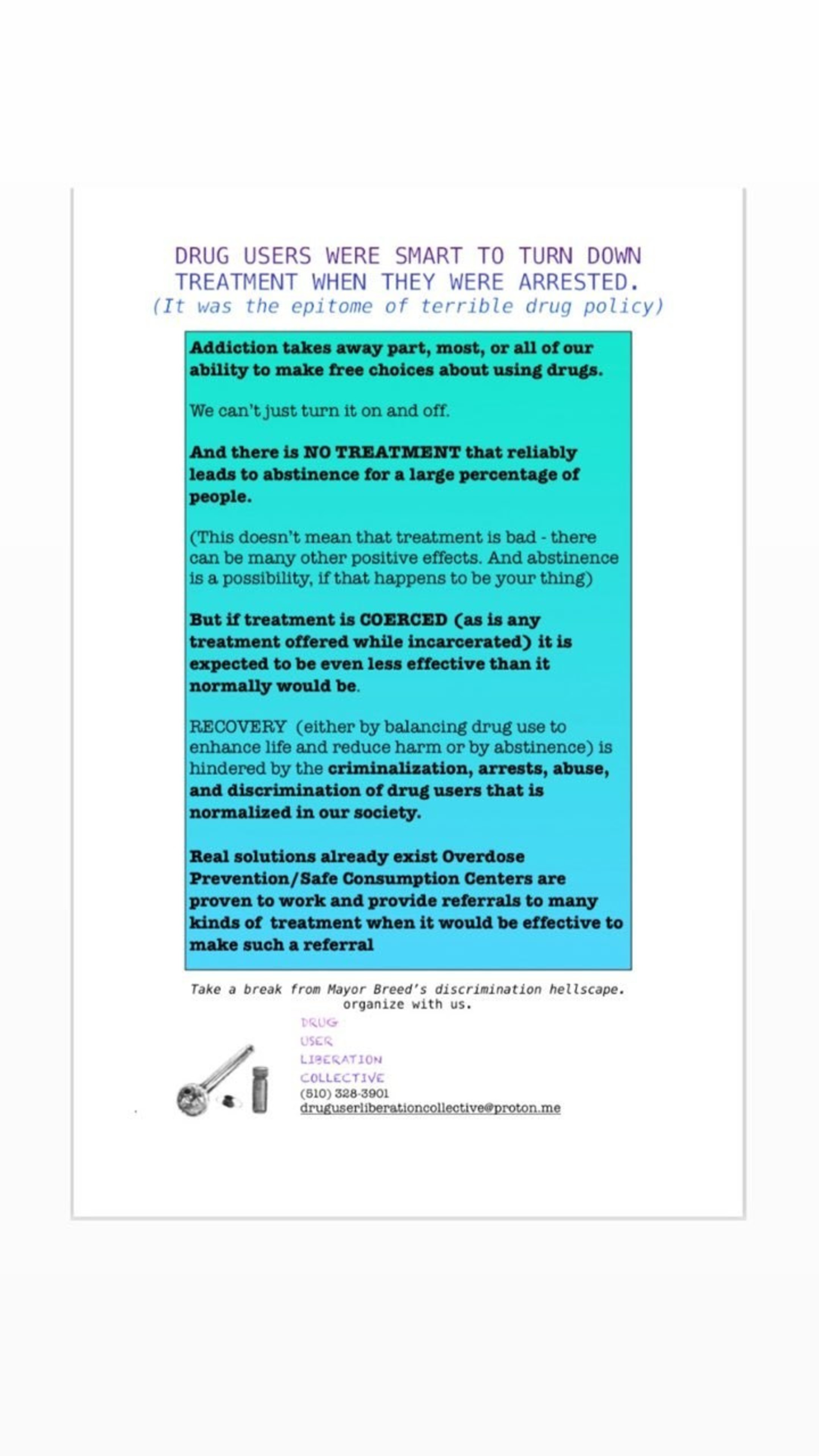A group representing drug users in San Francisco has posted signs promoting drug use and criticizing law enforcement across the Tenderloin neighborhood, the center of the city’s open-air drug scene.
Created by an entity called the Drug User Liberation Collective, the signs, measuring approximately 8 inches by 11 inches, aim to counter a recent initiative under Mayor London Breed to arrest people who use drugs in public, according to Nova Schultz, the creator of the campaign.
The signs blame Breed’s recent drug-enforcement measures for a surge of overdose calls between May and September last year. They argue the negative stigma of drug use is responsible for problems in the Tenderloin—rather than drug use itself.
“Downtown is for drug users,” one sign reads. “Yea we buy drugs and do drugs here. … It’s very literally not hurting you, your business or the economy.”
“Anti-drug user culture and laws = white supremacy,” reads another sign, citing data that shows Black people die from overdoses at a rate five times greater than white people in San Francisco.
Gallery of 5 photos
the slideshow
Black people made up 31% of the city’s fatal overdoses last year, despite accounting for only 5.7% of the local population.
Between January and November 2023, 752 people died from drug overdoses in San Francisco, more than any year prior, according to preliminary data from the Chief Medical Examiner’s Office.
San Francisco police made 788 arrests for drug use and 556 arrests for drug dealing between May 29 and Dec. 12. Very few of those individuals entered treatment after their release, according to data released in September.

‘It’s Illegal To Be Us’
Schultz said they spent over $500 of their own money on the campaign and they hope to rally other drug users to join their fight against anti-drug stigma. They said six people are in the Drug User Liberation Collective, which is a separate entity from the San Francisco Drug Users Union formed in 2007.
Isaac Jackson, a founder of San Francisco’s Drug Users Union, said he is also in the collective because he believes the views of drug users have been underrepresented across society. The Drug Users Union previously advocated for patient’s rights in methadone clinics and at San Francisco General Hospital, Jackson said.
“We felt that as consumers of social services, we had the right to make our comments known,” Jackson said. “Previously, we had no say in how we were treated at these institutions.”
But the flyers are not sitting well with some as many Tenderloin residents and business owners have complained of unsafe street conditions they attribute to the neighborhood’s drug activity. Parents in the neighborhood have said the street conditions have had a negative psychological impact on their children and businesses have lamented drug dealing on their doorsteps.

Randy Shaw, executive director of the Tenderloin Housing Clinic, argued there are “plenty of places” for people to use drugs in San Francisco other than the sidewalk in the Tenderloin.
“Tell me which neighborhood wants people shooting up in front of their businesses and residences in their neighborhood?” Shaw said. “People don’t want to go to a business where they have to walk over drug users.”
Schultz, who said they are a clinician for a Downtown mental-health organization and has previously used a different name, described themself as a “drug user in recovery.” They argued that the frustrations of residents, business owners and politicians are due to their own negative perceptions of drug use.
Schultz further contended that the violence and other illegal behavior sometimes associated with drugs is actually a function of drugs being illegal. They said their group wants the city to implement supervised drug-use facilities, create a regulated “safe supply” of drugs and stop the enforcement of drug laws.
“Our lives are inherently criminalized. It’s illegal to be us,” Schultz said, explaining that drug use isn’t a choice for many people. “People who use drugs are not morally corrupt.”

The city operated a safe-consumption site in United Nations Plaza for 11 months in 2022, reversing 333 overdoses during its tenure. However, the facility shut down as critics alleged it attracted drug use and shoplifting to the area.
The Mayor’s Office didn’t respond to a request for comment.
Del Seymour, who is 76 years old and founded the nonprofit CODE Tenderloin, said he finds it difficult to navigate the neighborhood’s drug-filled streets as an elderly person in recovery from addiction. He said he took the group’s message as a threat to law-abiding Tenderloin residents.
“No one group of people should dictate the behavior of a community,” Seymour said. “We will not be intimidated by a group of lawbreakers.”
In May 2023, a moderate-leaning political group called TogetherSF Action launched an ad campaign called “That’s Fentalife,” which aimed to press City Hall into addressing the fentanyl crisis by policing drug dealing and funding abstinence-based treatment programs.
Michael Moritz, who is chairman of The Standard, has provided funding to TogetherSF Action.
Schultz argued that many people can’t be cured of addiction by simply entering a treatment program, particularly when it’s forced upon them. They said they have been in drug treatment programs for 20 years but still use drugs.
“There is this thought that any drug user is able to make changes or quit drug use at any point in their life,” Schultz said. “That is just not true.”





